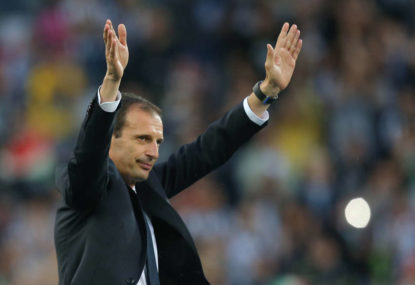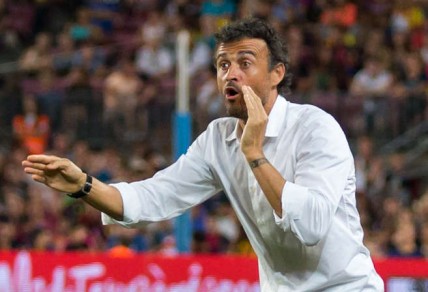WATCH: Chelsea forward escapes red for 'nasty' studs-up moment, somehow doesn't even cop a yellow
Arsenal fans were outraged that Chelsea striker Nicolas Jackson got off scot-free for this challenge in the Gunners' 5-0 win.

On July 16, 2014, 300 Juventus fans protested against the appointment of Maxi Allegri as the club’s new manager. About six months later, on January 6, Barcelona coach Luis Enrique was under fire amid rumours of squad discontent at the Catalan club.
A swift departure was anticipated.
Yet this Saturday, on June 6, Allegri and Enrique will take their places in opposite dugouts of Berlin’s Olympiastadion to not only contest the UEFA Champions League final, but also chase historic trebles for their respective clubs.
The astonishing turnaround in fortunes for both coaches has not been smooth, and highlights the cruel, brutal and unpredictable world of football management.
The credentials of predecessors produced shadows over Enrique and Allegri from the start – Pep Guardiola’s stylish trophy-laden stint at Barca and Antonio Conte’s dominance in Serie A.
Juventus fans were hysterical upon Allegri’s arrival, rival fans could not help but burst into fits of laughter. What was president Andrea Agnelli thinking, replacing Conte with someone who thought Pirlo was past his best while at AC Milan, and had left the Rossoneri in decline?
Barcelona fans were relatively nonchalant, willing to wait and see whether former player and youth coach Enrique could reproduce Guardiola’s tiki-taka football that Tata Martino had failed to replicate.
Tough positions to fill, yet nevertheless Allegri and Enrique both took bold and adventurous approaches to their new jobs. Allegri underwent a tactical evolution in an effort to become more ruthless. Enrique made tactical changes based on necessity, given the declining influence of key players.
Saturday’s battle is the result of two newly implemented styles, a battle between two tacticians mocked at different stages of the season. It will be an intriguing contest. Yet forget billing this match as an example of Barcelona’s attacking guile coming up against Juventus’ take on Italia’s catenaccio, it goes much deeper.
Under Conte, Juventus were an efficient beast, thriving in a 3-5-2 formation. Yet while they dominated in Italy, the team was found wanting in Europe. it led Conte to lament, “When you sit in a restaurant where you pay 100 Euros, you can not expect to eat with 10 euro.”
Allegri played his transformation smartly, gradually implementing his favoured 4-3-1-2 in place of the successful 3-5-2. It was a bold move, straying away from a winning product, but it was also astute.
The change in direction has given Juventus more fluidity in transitioning between defence and attack, depending largely on the side’s midfield. Key to Allegri’s formation has not been the evergreen Pirlo, with his expert passing, positioning and awareness. Nor the the much lauded Paul Pogba and tenacious Arturo Vidal.
It has been the box-to-box qualities of Claudio Marchisio, whose work ethic has assisted Pirlo, not renowned for his defensive prowess, carry out his regista role with less pressure. It has also freed up Pogba and Vidal to venture forward with increased license, allowing the plaudits to stream through.
Carlos Tevez has also been crucial for Allegri’s evolution, with the Argentinean almost given free rein at the Old Lady.
Often dropping deep to pick up possession, or drifting onto the wings, Tevez has been an outstanding source of inspiration for his teammates. Those in England quick to denounce his talents and motivations after a controversial end to his Manchester City career have been very quiet of late. Imagine if he had gone to the 2014 World Cup.

Where Allegri has reinvigorated his side in attack, Enrique has introduced a defensive steel to his Barcelona side, a trait often overlooked when coaches take charge of the Spanish giants.
Prior to their second leg tie against Bayern Munich, Barcelona had kept 11 clean sheets in 14 games, conceding just four goals. This came against the attacks of Real Madrid, Sevilla, Manchester City, Valencia and Paris Saint-Germain. They didn’t concede in the opening nine La Liga games and have given up just 21 goals in total.
At set pieces they have moved increasingly towards man-marking over zonal, or at least a mix, and it has turned them into a much more confident unit when defending from dead ball situations. Enrique, with the assistance of Juan Carlos Unzué, has also added an aerial threat to their attacking arsenal, with 22 goals scored from set pieces in La Liga this season.
Yet Barcelona are, and always will be, labelled as an attacking juggernaut, and Enrique deserves credit in retaining that focus while admittedly straying away from ‘the Barcelona way’.
Many will point out that his success has arrived due to inheriting a great squad and boasting the world’s most potent attacking trio – Lionel Messi, Luis Suarez and Neymar (MSN). But such an argument is far too simplistic.
Enrique has departed from Guardiola’s possession-obsessed style of football amid Andres Iniesta and Xavi Hernandez’s ageing bodies and their inability to play every week. He has had to deal with losing two vital and ever-present cogs from Guardiola’s era.
Enrique has adapted, introducing a game plan where Barcelona play increasingly on the counter, eradicating passing for passing’s sake and implementing the widespread use of long balls. At times the midfield is simply bypassed, unthinkable for some Catalans. He has made Barcelona less predictable, but in January many felt it was moving too far away from instilled ideals.
Space and positioning are still just as crucial, however, while a high pressing game is actually encouraged more than under Guardiola.
Thankfully, Enrique has been able to rely on Sergio Busquets anchoring his midfield system, as well new signing Ivan Rakitic, and to a lesser degree Rafinha, whose box-to-box styles of play assist Busquets defensively. Iniesta has adapted superbly to playing more direct, though his form has been patchy.
The onus from the Guardiola era to Enrique’s reign has shifted from midfield to the front third, with MSN now the dominant component. Enrique has greater appreciation for the centre forward and his midfield trio is based around exploiting that front-third talent.
Not many people could have predicted that MSN would combine so devastatingly, and indeed it is uncertain they would have done so under Guardiola’s tiki-taka. Enrique deserves plaudits for getting them to gel.
Messi plays from the right wing, often dropping deeper and alternating with Suarez as the central forward. Neymar plays highest out of the the three at times, breaking behind the lines with devastating speed. It is the ultimate attacking machine.
And that breathtaking attacking force will come up against one of Europe’s most well-drilled, well-oiled and well-organised machines in Allegri’s Juventus on Saturday.
As well as installing a ruthlessness and fluidity in attack, Allegri has also retained the catenaccio element in this Juventus side, led from the back by club stalwart Gianluigi Buffon.
They have been one of the most efficient teams in Europe since the Champions League group stages. Against Monaco they completed the job expertly, scoring an away goal and keeping a clean sheet at home.
In the first leg semi-final against Real Madrid they could have been ahead 3-1 or 4-1 towards the end, but managed a 2-1 victory at home. Faced with the necessity of a draw at the Bernabeu, once again Juve got it done.
The Madrid legs also highlighted Allegri’s willingness to reimplement his predecessor’s tactics, which have been similarly prevalent back in Serie A. When Allegri wants to close down matches he introduces a third central defender – most recently Andrea Barzagli – and reverts back to 3-5-2. It has been extremely effective.
In the 206 minutes Barzagli has played in Juventus’ Champions League campaign – one start and four substitute appearances – the Old Lady has failed to concede.
Similarly, Enrique has utilised Xavi to great effect, introducing the ageing star from the bench when he wanted to exert more control on matches and try to out-pass his opponents into submission, harking back to tiki-taka.
But Barcelona’s new gung-ho style was best exhibited in El Clasico back in March, where the Blaugrana uncharacteristically surrendered large chunks of possession to Real Madrid.
The Catalans beat Real at their own game, with Suarez scoring from a long-ball counter attack and Jeremy Mathieu heading home a corner, two distinctive areas Enrique has worked on. Against Guardiola’s Bayern, they surrendered the majority of possession, too.
Both Champions League finalists exhibit vibrant movement in the forward line, solidity at the back and impressive midfield combinations. Neither can be imprinted with an all-defining label of being defensive or attacking, This is not tiki-taka versus catenaccio, though it is clear Juventus are stronger in one department and Barcelona in the other.
Both Allegri and Enrique have methodically and steadfastly changed directions at Juventus and Barcelona, respectively. They have delivered under clouds of criticism, shadows of illustrious predecessors and amid patches of fan discontent.
That both have managed to collect domestic doubles in their debut campaigns is astonishing enough, and both deserve to turn that success into a treble with the addition of a Champions League medal.
Only one will prevail, however, and there is no clear favourite in this fixture. An intense and fascinating tactical battle is set to ensue, the result of two men persisting with change in the face of adversity.